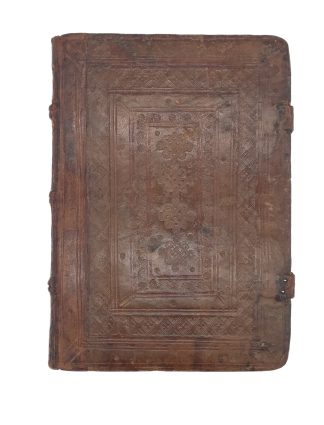HYGINUS
ONE OF RATDOLT’S FINEST
Poeticon Astronomicon.
Venice, Erhard Ratdolt, 1485£16,500.00
4to, 56 unnumbered ff, a-g8. Roman letter. Woodcut floriated initials, full page woodcut of ‘Sphaera Mundi’ on verso of first l., 47 woodcuts depicting constellations, zodiac signs and allegories of the planets. Intermittent marginal foxing, a few lower outer corners slightly soiled, wormhole to blank margin of final 10 ll, small tear from lower gutter of last not affecting text. A very good, wide margined copy in contemporary calf over boards, covers blind ruled to a panel design, first and third borders with small circular stamped tools, diaper roll with flowers in second border, roll of leaves in fourth, central panel with knotwork centrepieces and small circular tools. Spine with blind ruled raised bands, cross-hatched decoration in compartments, very thin layer of leather later superimposed on spine and joints, worked in blind to match the original decoration. Later leather clasps, flower-shaped brass anchor plates, lacking metal bosses at corners. Early small ink sketch of a hedgehog to lower corner of a1(recto); ms. correction to the caption of diagram on verso – this appears on other copies and it was possibly made in the printer’s workshop. 8 ms. lines from the Italian opera (melodramma) ‘Mutio Scaevola’ (1665) and 6 from ‘Il Maurizio’ (1687) on verso of last, probably late 17th century. Bookplate of Colonel Philippe Milon (1908-1992) to front pastedown.
Handsome and splendidly illustrated copy of the third edition of Hyginus’ Poeticon Astronomicon, in a fine contemporary Italian binding. In particular, the same small circular tools and elegant knotwork centrepieces appear on bindings made in Venice between the end of the 15th and beginning of the 16th century (see: De Marinis I, n. 370 and II, n. 1716). Another interesting connection between this copy and Venice is represented by the two ms. notes at the very end: the two operas quoted were written and first presented in this city. Interestingly, the first two verses read: ‘pupille amate / vezzose stelle’, which translates into ‘beloved eyes / charming stars’; it is possible that the writer was inspired to copy these words by the astronomical topic of this book.
The Poeticon Astronomicon is an extremely fascinating combination of a manual of astronomy and a book on Roman and Greek mythology. In the preface, Hyginus states that he wants to explore constellations and planets more deeply than his predecessor Aratus. The first book describes the celestial sphere and its circles, the second tells the myths connected to 42 constellations, 5 planets and the milky way, the third presents the shapes of each constellation and the fourth is concerned with their position and connections with the zodiac signs. Identified with the Roman historian Gaius Julius Hyginus (1st century BC) during the Reinassance, the author follows Ptolemy’s Almagest (II century BC) so closely – listing stars in the same order – that modern scholars tend to attribute the Poeticon Astronomicon to a more recent homonymous writer (c. II century BC).
The splendid woodcuts were commissioned by the printer Erhard Ratdolt to the Italian engraver Hyeronimus De Sanctis (15th century) and to the German artist Johannes Santritter (15th century) for the first illustrated edition of 1482. They are the first printed illustrations of the Greek constellations. There are dynamic pictures of all constellations, each overlaid with images from the Greek mythological tradition, as well as personifications of the Sun, Moon, Venus, Mercury, Jupiter, Saturn, and Mars, all equipped with chariots pulled by animals of allegorical significance. Some of them resemble the iconography found in manuscripts, while others are quite unique: for instance, Orion is unusually depicted as a knight in medieval armour. Although the positions of the stars in these images have little to do with those described by Hyginus or with their actual location, these woodcuts served as fundamental templates for the grand star atlases of the 17th and 18th century.
This copy is from the important library of Philippe Milon, a French colonial officer, ornithologist, traveller and bibliophile.
USTC 994235; ISTC ih00561000; Cantamessa N. 3866; Sander II 3473; Essling 286; Houzeau-Lancaster 1029; Goff H-561.In stock













